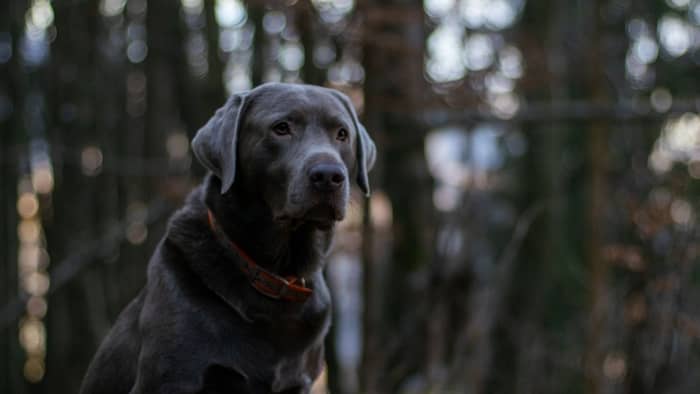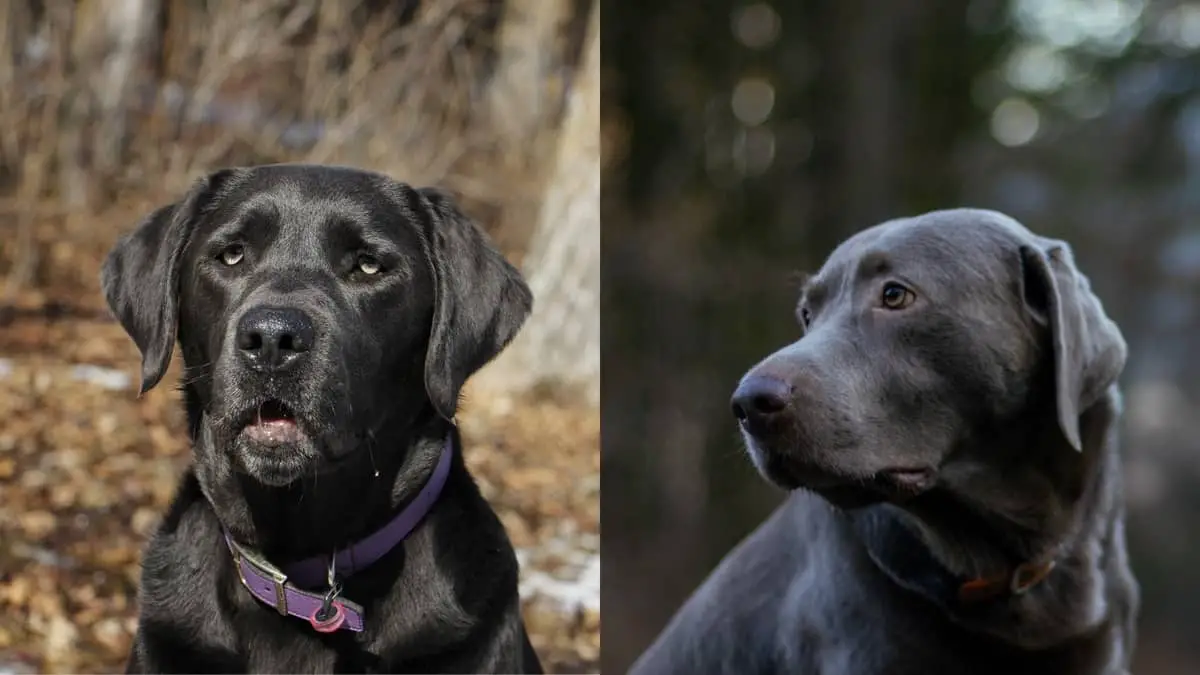Last Updated on September 22, 2023 by Linda Richard
Most people think there are only three lab colors – yellow, black, and brown. That’s not true, however. So, charcoal lab vs silver lab – here are 6 specifics to consider. We’ll touch on what makes these color variations special, why is there so much controversy around them, and what are some of the health, physical, and temperament specifics you ought to keep in mind before getting such a dog.
Table of Contents
Charcoal Lab vs Silver Lab
If the “main” lab colors are yellow, black, and brown, what exactly are charcoal and silver labs? Simple – they are variations of black and brown labs. Charcoal labs are just black labs with a special color dilution gene and silver labs are brown ones with that same color dilution gene.
Charcoal Lab vs Silver Lab – Genetic Differences
We’ve talked about color dilution before but the simplest way to explain it is that it’s the presence of a certain recessive gene that determines the coat color of the dog. In the case of both charcoal and silver labs, that’s the “d” locus. It’s the recessive variant of the dominant D locus. These color loci (plural of locus) go in pairs – either DD, Dd, or dd.
As D is the dominant locus, this means that whenever D is present (DD and Dd), the color of the dog’s coat isn’t going to be diluted and it’s going to be the standard black, brown, or yellow.
This makes it seem like diluted-color dogs should be a third of all dogs but that’s not actually how it works. Because the “d” locus is recessive, both dog parents have to have diluted coats themselves. And since most breeders (used to) avoid breeding dogs with diluted colors, charcoal and silver labs are pretty rare.
Long story short, both silver and charcoal labs have their colors for the exact same reason – the presence of the recessive dd loci combination. The only difference between them is that one is a type of black lab and the other – brown.
Silver Lab vs Charcoal Lab Temperament
If silver labs are just brown labs with a different color gene and charcoal labs are just black labs with that same different gene, is there a difference in the temperament of the two dogs? For that matter, is there a temperament difference between silver and brown labs and charcoal and black labs?
In a word – no, on both questions. The genes and loci that determine a dog’s coat color have no relation whatsoever with its temperament. If there are any tendencies for different personalities, temperament, intelligence, and trainability between the different color labs (and some claim there are such tendencies), those aren’t due to these color genes.
The much more likely explanation is that many dog breeders have pigeon-holed different-colored labs into different tasks. Black labs were typically preferred for hunting because of a former misconception that they are smarter; yellow labs were preferred for social work because they were believed to be more obedient, and brown labs were preferred as pets as they were thought to be more social.
So, while there’s no genetic basis for any of these claims, the fact that breeders believed them and acted upon those beliefs may have made them partly true.
What does this mean?
It means that if your charcoal lab comes from a long line of hunting dog labs, you can expect it to be smarter and more trainable. That’s not due to its coat, however, it’s just due to its heritage. Same with silver labs.
Chocolate Lab vs Silver Lab Physical Characteristics
As with their temperament, there don’t seem to be any physical differences between these two lab coat colors. At least none based on their color genes. If your dog comes from a hunting line it may have better physicality but that’s about it.

Silver Or Charcoal English Lab Dogs
Both silver and charcoal labs can be of the English lab variation too, although that appears to be a rare occurrence. As we’ve discussed before, the main difference between English and American labs is in the height and athleticism, as well as the calmer temperament of English dogs. Silver and charcoal English labs are rare, however, so you may have to look quite a bit to find one.
Charcoal Lab vs Silver Lab Health
There isn’t much of a difference between charcoal and silver labs. However, there is a difference between them and black and brown labs – the Color Dilution Alopecia skin condition. While unfortunate and untreatable, this condition is manageable. Still, it is one more reason why some breeders and experts are against the breeding of color diluted dogs.
Another health-related concern is that there is often too much inbreeding involved in the creation of new charcoal and silver lab pups. That’s due to the limited stock of these dogs and the need for them to be bred only with other color diluted labs. Such inbreeding can cause a wide host of other health issues and is why many frowns upon the practice of breeding charcoal and silver labs.
That being said, if you get health certificates for your pups and their parents, and if everything is above board – there should be no issues.
Charcoal Lab vs Silver Lab Price
There isn’t a major difference between the price tags of these two lab colors. However, they are both more expensive than “standard” labs. You can expect to pay somewhere between $1,000 and $1,500 on average for a color diluted pup.
What About Champagne Labs?
If charcoal labs are just black labs with color dilution and silver labs are brown labs with color dilution, what are yellow labs with that same condition called?
They are called champagne labs. We’ve talked about them before here and most of the things we said about charcoal and silver labs apply to them as well.
So, Charcoal Lab vs Silver Lab – Are There Any Significant Differences, and Should You Consider Getting Such A Dog?
There are virtually no differences between charcoal and silver labs except the exact diluted color they have. There are a few major differences between these two color variations and the standard black, brown, and yellow labs, however. If you insist on getting such a dog you can expect to have to pay extra, to watch out for color dilution alopecia, and to make sure that the pup is healthy overall and doesn’t carry any hereditary health problems due to inbreeding.
Read more about: 155 Silver Lab Names Female Dogs Will Wear Proudly
What color Labrador is most expensive: a complete guide
FAQs
Are silver labs purebred?
Depends on who you ask. Many kennel clubs don’t recognize silver, charcoal, and champagne labs as purebred dogs. These rare colors are also almost never accepted in the major dog shows. At the same time, however, many experts and registries do recognize these dogs as purebred labs, at least as long as they tick the same characteristics as black, brown, and yellow labs.
So, if you’re getting your silver or charcoal lab from a reputable breeder, if the dog has been bred according to the best practices, and if you get adequate health certificates for the pup and its parents, you can very well consider it a purebred lab. Some kennel clubs will still frown upon the breeding and very existence of your silver lab and won’t allow it in dog shows, but it will be “a real lab” for all other intents and purposes.


1 thought on “Charcoal Lab Vs Silver Lab – 6 Specifics To Consider”
Comments are closed.